두개골 골절 Skull fracture
두개골 골절의 종류
- 두개골을 두골 또는 머리뼈라고 한다.
- 교통사고나 안전사고 등으로 머리를 다치거나, 운동이나 장난을 하다가 머리를 다치든지 두개골이 골절되기도 한다.
- 두개골에 골절이 생길 때 두개골만 골절되기도 하고,
- 두개골 골절과 두개 강 내에 있는 뇌 손상이 생길 수 있고, 두개강 내에 있는 혈관이 터져 두개강 내 출혈이 생길 수 있다.
- 머리(두부)를 심하게 다쳤을 때 두개골은 골절되지 않았지만 두개 강 내에 있는 뇌가 크게 손상될 수 있고 뇌에 출혈이 생겨 그로 인해 사망할 수 있다.
- 탁구공의 일부분이 깨질 때 깨진 탁구공 껍질 일부가 탁구공의 안 쪽으로 밀려들어간 것처럼 골절된 두개골의 일부가 두개골 강 속으로 밀려들어갈 수 있다.
- 이런 종류의 두개골 골절을 함몰 두개골 골절(Depressed skull fracture)이라고 한다.
- 그와 반대로, 두개골이 심하게 골절되어도 두개골 강 속에 있는 뇌가 아주 조금 손상될 수 있다.
- 그렇지만 두개골이 골절될 정도만큼 머리를 크게 다쳤을 때는 두피, 두개골, 뇌 모두가 동시 손상되는 것이 보통이다.

사진 94. 두피 좌상
Copyright ⓒ 2011 John Sangwon Lee, M.D.. FAAP
함몰 두개골 골절
- 탁구공 껍질의 일부분이 탁구공 안 쪽으로 깨져 밀려들어간 것처럼 골절된 두개골의 일부가 두개 강 속으로 밀려들어갈 수 있다. 이런 종류의 두개골 골절을 함몰 두개골 골절(Depressed skull fracture)이라고 한다.
- 그와 반대로, 두개골이 심하게 골절되어도 두개 강 속에 있는 뇌가 아주 조금만 손상될 수도 있다.
- 그렇지만 두개골이 골절될 정도 머리를 크게 다쳤을 때는 두피, 두개골, 뇌 모두가 동시 손상되는 것이 보통이다.
선상 두개골 골절
- 두개골에 가는 금만 간 골절을 선상(線狀) 두개골 골절(Linear skull fracture)이라 한다.
분쇄상 두개골 골절
- 두개골의 일부가 여러 조각으로 골절된 두개골 골절을 분쇄 두개골 골절(Comminuted skull fracture)이라고 한다.
복잡 두개골 골절
- 두개골 골절을 단순 두개골 골절(Simple skull fracture)과 복잡 두개골 골절(Compound skull fracture)로 분류하기도 한다.
- 골절된 두개골 부분의 바로 위 두피가 손상되지 않았을 때의 두개골 골절을 단순 두개골 골절이라고 한다.
- 두피 손상도 있고 두개골 골절도 있을 때 두개골 골절을 복잡 두개골 골절이라고 한다.
- 골절의 형태에 따라
-
- 선상 복잡 두개골 골절,
- 함몰 복잡 두개골 골절,
- 분쇄 복잡 두개골 골절 등으로 두개골 골절을 나누기도 한다.
- 두개골 일부가 골절될 수 있고 여러 부위가 동시 골절될 수 있다.
- 두개골을
-
- 전두개골,
- 측두개골,
- 후두개골,
- 두정골,
- 두개골저 등 분류하고
- 각 두개골 조각에 생긴 골절을 그 두개골 조각의 이름에 따라
-
- 전두개골 골절,
- 후두개골 골절,
- 두개골저 골절(Basal or Basilar skull fracture) 등으로 두개골 골절을 분류할 수 있다.
두개골 골절의 원인
- 분만 중 아기의 두부가 엄마의 산도에 눌리어 두개골이 골절될 수도 있고 겸자로 분만할 때도 아기의 두개골이 골절될 수 있다.
- 높은 데서 떨어져 머리를 부딪쳤을 때,
- 어디에 머리를 심하게 부딪칠 때,
- 교통사고나 안전사고로 두개골이 골절될 수 있고
- 아동 학대로 두개골이 골절될 수 있다.
두개골 골절의 증상 징후
- 두개골 골절의 종류와 정도, 두개 골절이 생긴 두부 부위, 두개골이 골절될 때 생길 수 있는 두개 강 속 뇌 손상의 정도 등에 따라 증상 징후가 다르다.
- 분만 중 아기의 머리가 산도에 세게 눌릴 때 생긴 신생아 두개골 골절의 증상 징후는 일반적으로 경미하고 때로는 증상 징후가 거의 없을 수 있다.
- 계단 등 높은데서 그 아래로 떨어진다든지, 책상 위나 다른 높은 데에서 바닥으로 떨어질 때 두개골이 경미하게 골절될 수 있고, 심하게 골절될 수 있다.
- 두개골이 골절될 때 까무러치듯이 울 수 있고, 얼굴이 창백해지고, 구토하고 잠시 동안 의식을 잃을 수 있다.
- 때로는 전신경련을 할 수 있다.두혈종, 두부 외상 참조.
- 단순 선상 두개골 골절이 경미하게 생길 때 증상 징후가 거의 없거나 증상 징후가 경미하게 나타날 수 있다.
- 골절이 생긴 두개골 부위 바로 위에 있는 두피가 붓고 그 두피를 손으로 만지면 좀 말랑말랑하고 아플 수 있다.
- 태어 날 때 신생아에게 생긴 단순 선상 두개골 골절은 두혈종을 동반할 때가 많다.
- 두개골이 경미하게 골절되었을 때는 머리가 아프고 구토하고 어지럽고 기운이 없고 얼굴이 창백할 수 있다.
- 두개골이 심하게 골절되었을 때는 두개골이 변형될 수 있다.
- 두개골의 밑 부위-두개골 기저(頭蓋骨基底) 골절이 생기면 두개골 강 내에 있는 뇌척수액이나 두개 강 내 피가 골절된 두개골 사이를 통해서 콧구멍 속, 목구멍 속, 귓구멍 속, 또는 안구 속 등으로 흘러나올 수 있다.
- 두개골이 골절되었을 때 귓바퀴의 바로 뒤 부위에 있는 유양돌기 부위에 피가 맺히고 멍들 수 있다. 이런 징후를 “배틀 징후(Battlle sign)”라고 한다.
- 두개골저 골절이 있을 때 유양돌기의 부위에 피가 맺힐 수 있고 두개강 내 피나 척수액이 안구 속이나 안구 주위 속으로 흘러나와 두 눈이 래쿤(너구리 비슷한 북아메리카 산 포유동물) 눈같이 보일 수 있다. 이런 징후를 래쿤 눈 증후(Racoon eye sign)라고 한다.
- 코구멍 속에서, 귓구멍 속에서 척수액과 피가 흘러나올 수 있다.
- 12개의 뇌신경들 중 일부가 마비될 수 있다.
- 뇌 척수액이 귓구멍 속으로 흘러나올 때 귀젖이 흘러나오는 것으로 오진할 수 있다.
- 뇌 척수액이 비강 속으로 흘러나올 수 있다.
- 두개골이 골절되면서 이런 증상 징후가 있을 때는 상당히 위험 상태에 있는 두개골기저 골절이 있다는 것을 의미한다.
- 제 1 뇌신경 손상이 생기면 냄새를 잘 맞지 못한다.
- 두개골이 아주 심하게 골절되었을 때는 전신경련을 할 수 있고 혼수될 수 있다.
- 양쪽 동공의 크기에 차이가 날 수 있다.
- 이 정도로 여러 종류의 증상 징후가 있으면서 두개골이 심하게 골절되었을 때 응급으로 적절히 치료하지 않으면 생명에도 위험할 수 있다.
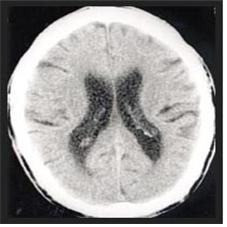
사진97. 두부 CT 스캔
Copyright ⓒ 2011 John Sangwon Lee, M.D., FAAP
두개골 골절의 진단
- 증상 징후와 진찰소견 등을 종합해서 두개골(두개골)이 골절되었다고 의심되면 두개골 X-선 사진 검사, CT 스캔 검사, MRI 검사 등으로 확진할 수 있다.
- 복잡 두개 골절이 있을 때는 뇌 일부가 골절된 두개골 사이로 삐져나올 수 있다. 이 경우, 언뜻 보고서도 두개골이 골절됐다는 것을 쉽게 진단할 수 있다.
- 경미하게 골절되었을 때는 육안으로 두부를 보고 두개골 골절이 있다는 것을 쉽게 진단할 수 없다.
- 두개골 기저(頭蓋骨基底)에 경미한 골절이 있을 때는 두개골 X-선 사진 검사로 골절된 부위를 찾기가 힘든 경우도 있다.
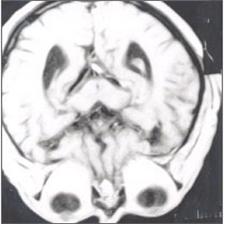
사진 100. 횡면 두부 MRI 사진
Copyright ⓒ 2011 John Sangwon Lee, M.D., FAAP
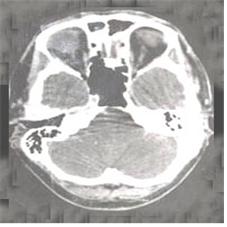
사진 98. 두부 CT 스캔
Copyright ⓒ 2011 John Sangwon Lee, M.D., FAAP
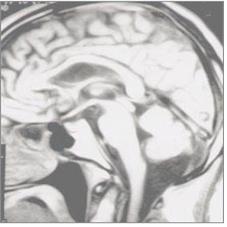
사진 99. 종면 두부 MRI 사진
Copyright ⓒ 2011 John Sangwon Lee, M.D. FAAP
두개골 골절의 치료
-
두개골 골절의 종류와 정도, 두개골이 골절될 때 생긴 다른 외상의 유무 등에 따라 치료가 다르다.
-
두개골 골절이 의심되면 의료구급대나 병원 응급실 또는 단골 소아청소년의사에게 긴급 전화 상담 진료를 받는다. 그들의 지시에 따라 구급차나 다른 교통수단으로 종합 병원 응급실로 빨리 옮겨야 한다.
-
의료구급대원이나 의사가 환아가 있는 곳에 도착하기 전이나 병원 응급실에 환아를 데리고 가는 중 의사의 지시에 따라 적절히 응급치료를 한다.
-
뇌가 손상되지도 않고 증상 징후가 거의 없는 경미한 두개골 골절은 특별한 치료가 요하지 않고 의사의 지시에 따라 관찰적 치료를 해도 된다.
-
그렇지만 두개골 골절의 종류와 정도에 상관없이 전신경련이나 두개강 내에 출혈이 생기는지 조심히 관찰적 치료를 해야 한다.
-
두개골 골절과 뇌 손상이 심하게 생겨 있을 때는 의식의 일부 또는 전부를 잃고 쇼크에 빠질 수도 있다.
-
이때는 침착하게 급히 인간 생명 유지 기본 심폐 소생술 응급치료를 해야 한다.
-
이때 가능한 한 환아를 현장에서 다른 곳으로 함부로 옮겨서도 안 된다.
-
인간 생명 유지 기본 심폐 소생술을 할 때, 맨 먼저, 숨을 정상적으로 쉬는지 확인하고 만약 숨을 제대로 쉬지 못하면 기도를 확보하고 환아의 입 또는 입과 코에 처치자의 입을 대고 인공호흡을 시작하고, 심장이 뛰지 않거나 아주 느리게 뛸 때는 심장 마사지를 동시 한다.
-
숨을 쉬게 하고 심장이 뛰도록 하는 기본 심폐 소생술을 필요에 따라 한다.
-
목을 꼭 죄게 해서 기도를 막히게 하는 옷을 느슨하게 풀어주고 두피나 신체 다른 부위에 생긴 열상이나 자상 등에서 나는 출혈을 지혈시킨다.
-
두개골이나 뇌가 교통사고 등으로 크게 다쳤을 때는 신체 다른 부위에도 외상이 있을 수 있다. 그런 외상이 있으면 그것도 동시 적절히 응급 치료 한다.
-
쇼크는 산소호흡, 인공호흡, 심장 마사지 등 인간 기본 생명 유지 심폐 소생술로 치료 한다.
-
이런 치료의 순서를 일률적으로 정하기 어려우나
- 기도를 확보하고,
- 숨쉬기를 복구(AB)하고,
- 혈액순환과 심장 기능회복(C),
- 진단(D) 치료 등의 순서로 처치한다.
-
즉 ABCD 순서로 응급처치 한다.
-
심하게 출혈하면 지혈시키는 동시 호흡이 곤란하면 숨을 쉬게 하는 처치가 우선순위이다.
-
그와 동시, 의사나 의료구급대원 긴급 전화 상담을 해서 그들의 지시에 따라 응급처치를 시작하면서 구급차나 다른 적절한 교통수단으로 환아를 급히 종합 병원 응급실로 데리고 간다.
-
두개골 골절의 75%는 단순 선상 두개골 골절에 속하고 합병증이 없는 단순 선상 두개골 골절은 특별한 치료를 할 필요가 없는 것이 보통이다.
-
그렇지만 단순 선상 두개골 골절을 입었을 때 두부에 심한 타박상을 입을 수 있고 뇌가 심하게 손상될 수 있다.
-
따라서 아무런 증상이 없어도 하루 이틀 동안 입원해서 적어도 관찰적 치료를 받는 것이 좋다.
-
두개골이 골절되어 두개골의 일부가 두개골 강 속으로 함몰되었을 때는 함몰 두개골 골절이 생긴 두개골의 바로 밑에 있는 뇌 실질이 찢어지거나 뇌 실질이 타박상을 입을 수 있다.
-
함몰 두개골 골절이나 다른 종류의 두개골 골절이 다 나은 후에 후유증으로 간질이 발생할 수 있다.
-
함몰 두개골 골절의 정도에 따라 함몰 골절이 생긴 두개골을 수술 복구 치료를 하는 것이 보통이다.
-
찢어지거나 찔린 두피는 소독된 거즈로 피를 깨끗이 닦고 베타다인 살균액 등으로 살균 소독하고 필요에 따라 찢어진 두피를 봉합수술 치료를 한다.
-
필요에 따라 파상풍백신 예방접종을 받는다.
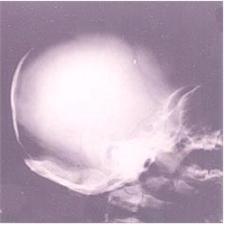
사진 101. 영아의 정상 두개골 측면 X-선 사진
Copyright ⓒ 2011 John Sangwon Lee, M.D., FAAP

사진 102. 영아의 정상 두개골 전후면 X-선 사진
Copyright ⓒ 2011 John Sangwon Lee, M.D., FAAP
Skull fracture 두개골 골절
Types of skull fractures
• The skull is called the head bone
• Head injuries due to traffic accidents or safety accidents, head injuries while playing sports or pranks, or skull fractures.
• When a fracture occurs in the skull, only the skull is fractured;
• Skull fractures and damage to the brain within the cranial cavity may occur, and blood vessels within the cranial cavity may rupture, resulting in intracranial hemorrhage.
• When the head (head) is seriously injured, the skull is not fractured, but the brain within the cranial cavity can be seriously damaged and the brain can bleed and die as a result.
• When a part of a ping-pong ball is broken, part of the fractured skull can be pushed into the cranial cavity just as part of the broken ping-pong ball shell is pushed into the inside of the ping-pong ball.
• This type of skull fracture is called a depressed skull fracture.
• Conversely, even a severe fracture of the skull can cause very little damage to the brain in the cranial cavity.
• However, when a head injury is severe enough to fracture the skull, it is common to simultaneously damage the scalp, skull, and brain.

Photo 94. Scalp strain Copyright ⓒ 2011 John Sangwon Lee, M.D., FAAP Depressed skull fracture
• Part of a fractured skull may be pushed into the cranial cavity just as part of the shell of a ping-pong ball is broken and pushed into the ping-pong ball. This type of skull fracture is called a depressed skull fracture.
• Conversely, even a severe fracture of the skull may cause very little damage to the brain in the cranial cavity.
• However, when the head is seriously injured to the point that the skull is fractured, it is common to simultaneously damage the scalp, skull, and brain.
Linear skull fracture
• A fine interstitial fracture of the skull is called a linear skull fracture.
Comminuted skull fracture
• A skull fracture in which a portion of the skull is fractured into multiple pieces is called a comminuted skull fracture.
Compound skull fracture
• Skull fractures are sometimes classified as simple skull fractures and compound skull fractures.
• A skull fracture when the scalp just above the fractured skull is not damaged is called a simple skull fracture.
• When there is a scalp injury and a skull fracture, a skull fracture is called a complex skull fracture.
• Depending on the type of fracture
o Linear complex skull fractures;
o Recessed complex skull fractures;
o Cranial fractures are sometimes divided into comminuted complex skull fractures.
• Part of the skull may be fractured and several parts may be fractured simultaneously.
Skull
o frontal skull,
o Temporal skull,
o occipital bone,
o parietal bone,
o base of the skull,
etc.
• Fractures in each skull fragment are named after that skull fragment.
• Fractures of the frontal skull;
o Fractures of the epiglottis;
o A skull fracture can be classified as a basal or basilar skull fracture.
Causes of skull fractures
• During delivery, the baby’s head may be crushed by the mother’s birth canal, and the baby’s skull may be fractured during delivery with forceps.
• When you fall from a high place and hit your head,
• Where you hit your head hard,
• The skull may be fractured in a traffic accident or safety accident. • Child abuse can cause skull fractures.
Symptoms, Signs of a skull fracture
• Symptoms vary depending on the type and severity of the skull fracture, the region of the head where the skull fracture occurred, and the degree of brain damage in the cranial cavity that can occur when the skull is fractured
• Symptomatic signs of a neonatal skull fracture caused when the baby’s head is pressed against the birth canal during labor are usually mild, and sometimes there may be few symptoms.
• When you fall from a high place, such as a staircase, or when you fall to the floor from a desk or other high place, you can fracture your skull slightly or severely.
• You may cry black when your skull is fractured, your face may turn pale, you may vomit, and you may lose consciousness for a short time.
• Occasionally may have generalized convulsions. See cephaloma, head trauma.
• When a simple linear cranial fracture is mild, there may be few or mild symptoms.
• The scalp just above the fractured skull area is swollen, and if you touch the scalp with your hands, it may feel soft and painful.
• Simple linear skull fractures in newborns at birth are often accompanied by cephalohematoma.
• Minor fractures of the skull may cause a headache, vomiting, dizziness, weakness, and a pale face.
• When the skull is severely fractured, the skull can be deformed.
• When a fracture occurs at the base of the skull – the base of the skull, cerebrospinal fluid or intracranial blood in the cranial cavity can leak into the nostrils, the throat, the ear canal, or the eyeball through the space between the fractured skulls. have.
• When the skull is fractured, the area of the mastoid process just behind the pinna may bleed and bruise. These signs are called “Battle signs”.
• When there is a fracture of the skull base, the area of the mastoid process may bleed, and intracranial blood or spinal fluid may leak into or around the eyeball, making the eyes look like those of a raccoon (a North American mammal similar to a raccoon). This sign is called the Racoon eye sign.
• Spinal fluid and blood may leak from the nostrils and from the ear canals. • Some of the 12 cranial nerves can be paralyzed.
• When cerebrospinal fluid leaks into the ear canal, it may be misdiagnosed as udder.
• Cerebrospinal fluid may leak into the nasal passages.
• When your skull fractures and you have these symptoms, it means you have a fracture of the base of the skull that is at high risk.
• If the primary cranial nerve is damaged, it is difficult to smell.
• Very severe fractures of the skull can lead to generalized convulsions and coma. • There may be differences in the size of both pupils.
• When there are so many different types of symptoms and severe fractures of the skull, it can be life-threatening if not properly treated in an emergency.

Picture 97. CT scan of the head Copyright ⓒ 2011 John Sangwon Lee, M.D., FAAP
Diagnosis of skull fractures
• If it is suspected that the skull is fractured by combining symptomatic signs and examination findings, the diagnosis can be confirmed with a skull X-ray examination, CT scan examination, or MRI examination.
• In complex cranial fractures, parts of the brain may protrude through the fractured skull. In this case, at first glance, it is easy to diagnose that the skull is fractured.
• When there is a minor fracture, the presence of a skull fracture cannot be easily diagnosed by looking at the head with the naked eye.
• When there is a minor fracture at the base of the skull, it may be difficult to find the fractured site on an X-ray examination of the skull.

Picture 100. Transverse head MRI picture Copyright ⓒ 2011 John Sangwon Lee, M.D., FAAP

Picture 98. CT scan of the head Copyright ⓒ 2011 John Sangwon Lee, M.D., FAAP Picture

99. Longitudinal head MRI picture Copyright ⓒ 2011 John Sangwon Lee, M.D. FAAP
Treatment of skull fractures
• Treatment differs depending on the type and severity of skull fractures, and whether or not there is any other trauma that occurred when the skull fractured.
• If you suspect a skull fracture, seek emergency phone consultation from a medical emergency department, hospital emergency room, or regular pediatrician. Follow their instructions and get to the general hospital emergency room quickly by ambulance or other means of transportation.
• Provide appropriate emergency treatment according to the doctor’s instructions before medical paramedics or doctors arrive at the patient’s place or while taking the child to the hospital emergency room.
• Minor skull fractures with no brain damage and few symptoms do not require special treatment and can be treated observationally as directed by a doctor.
• However, regardless of the type and severity of skull fracture, careful observational treatment should be performed for generalized seizures or intracranial hemorrhage.
• Severe skull fractures and brain damage can result in loss of some or all of your consciousness and shock.
• At this time, you should calmly and urgently give first aid to basic cardiopulmonary resuscitation (CPR) to maintain human life.
• In this case, if possible, the patient should not be recklessly moved from the site to another place.
• When performing basic cardiopulmonary resuscitation (CPR) for human life support, the first thing to do is to check that you are breathing normally, and if you are not breathing properly, secure an airway and start artificial respiration by placing the person’s mouth over the patient’s mouth or mouth and nose When not running or running very slowly, do a heart massage at the same time.
• Perform basic cardiopulmonary resuscitation (CPR) as needed to help you breathe and allow your heart to beat.
• Loosen clothing that is constricting the neck and obstruct the airways, and stop bleeding from lacerations or cuts on the scalp or other parts of the body.
• When the skull or brain is seriously injured in a traffic accident, other parts of the body may also have trauma. If there is such a trauma, emergency treatment should be provided at the same time.
• Shock is treated with basic human life support CPR, including oxygen respiration, artificial respiration, and cardiac massage.
• Although it is difficult to uniformly determine the order of these treatments,
o Secure the airway,
o restore breathing (AB);
o Blood circulation and heart function restoration (C),
o Treat in the order of diagnosis (D) treatment, etc.
• In other words, perform first aid in the order of ABCD.
• In case of severe bleeding, hemostasis is given. If breathing is difficult at the same time, breathing treatment is a priority.
• At the same time, make an emergency phone consultation with a doctor or paramedic and immediately take the child to the general hospital emergency room by ambulance or other suitable means of transportation, starting first aid according to their instructions.
• 75% of skull fractures belong to simple linear skull fractures, and simple linear skull fractures without complications usually do not require special treatment. • However, a simple linear skull fracture can result in severe head bruising and severe brain damage.
• Therefore, even if there are no symptoms, it is recommended to be hospitalized for a day or two and receive at least observational treatment.
• When the skull is fractured and a portion of the skull is depressed into the cranial cavity, the brain parenchyma just below the skull fractured may be torn or the brain parenchyma may be bruised.
• Epilepsy may occur as a sequelae after a recessed skull fracture or other types of skull fracture have healed.
• Depending on the severity of the inverted skull fracture, it is common to perform surgical restoration of the inverted fractured skull.
• Torn or stabbed scalp, wipe the blood clean with sterilized gauze, sterilize with betadyne sterilizing solution, etc. If necessary, suture the torn scalp.
• Get a tetanus vaccine as needed.

Picture 101. Lateral X-ray of a normal skull of an infant Copyright ⓒ 2011 John Sangwon Lee, M.D., FAAP

Picture 102. Anterior and posterior X-ray of a normal skull of an infant Copyright ⓒ 2011 John Sangwon Lee, M.D., FAAP
출처 및 참조 문헌 Sources and references
- NelsonTextbook of Pediatrics 22ND Ed
- The Harriet Lane Handbook 22ND Ed
- Growth and development of the children
- Red Book 32nd Ed 2021-2024
- Neonatal Resuscitation, American Academy Pediatrics
- www.drleepediatrics.com 제16권 소아청소년 정형외과 질환
- www.drleepediatrics.com제8권 소아청소년 호흡기 질환
- www.drleepediatrics.com제9권 소아청소년 소화기 질환
- www.drleepediatrics.com제10권. 소아청소년 신장 비뇨 생식기 질환
- www.drleepediatrics.com제11권. 소아청소년 심장 혈관계 질환
- www.drleepediatrics.com제12권. 소아청소년 신경 정신 질환, 행동 수면 문제
- www.drleepediatrics.com제13권. 소아청소년 혈액, 림프, 종양 질환
- www.drleepediatrics.com제14권. 소아청소년 내분비, 유전, 염색체, 대사, 희귀병
- www.drleepediatrics.com제15권. 소아청소년 알레르기, 자가 면역질환
- Red book 29th-31st edition 2021
- Nelson Text Book of Pediatrics 19th — 21st Edition
- The Johns Hopkins Hospital, The Harriet Lane Handbook, 22nd edition
-
Childhood Emergencies in the Office, Hospital and Community, American Academy of Pediatrics
-
Emergency Medical Service for Children, By Ross Lab. May 1989. p.10
-
Emergency care, Harvey grant, and Robert Murray
-
Emergency Care Transportation of Sick and Injured American Academy of Orthopaedic Surgeons
-
Emergency Pediatrics A Guide to Ambulatory Care, Roger M. Barkin, Peter Rosen
-
Immediate care of the acutely ill and injured, Hugh E. Stephenson, Jr
-
The Critically Ill Child, Diagnosis and Management, Edited by Clement A. Smith
-
Emergency Medical Services for Children: The Role of the Primary Care Provider, America Academy of Pediatrics
-
Quick Reference To Pediatric Emergencies, Delmer J. Pascoe, M.D., Moses Grossman, M.D. with 26 contributors
-
Manual of Emergency Care
-
응급환자관리 정담미디어
-
소아가정간호백과–부모도 반의사가 되어야 한다, 이상원
-
Neonatal Resuscitation American heart Association
-
Neonatology Jeffrey J.Pomerance, C. Joan Richardson
-
Pediatric Resuscitation Pediatric Clinics of North America, Stephen M. Schexnayder, M.D.
-
Pediatric Critical Care, Pediatric Clinics of North America, James P. Orlowski, M.D.
-
Preparation for Birth. Beverly Savage and Dianna Smith
- Infectious disease of children, Saul Krugman, Samuel L Katz, Ann A. Gershon, Catherine Wilfert
-
The Harriet Lane Handbook 19th Edition
-
소아과학 대한교과서
-
제1권 소아청소년 응급의료 참조문헌과 출처
-
Other
Copyright ⓒ 2015 John Sangwon Lee, MD., FAAP
“부모도 반의사가 되어야 한다”-내용은 여러분들의 의사로부터 얻은 정보와 진료를 대신할 수 없습니다.
“The information contained in this publication should not be used as a substitute for the medical care and advice of your doctor. There may be variations in treatment that your doctor may recommend based on individual facts and circumstances. “Parental education is the best medicine.”